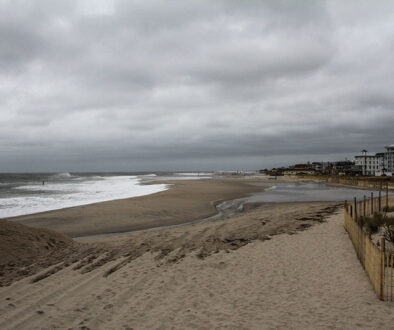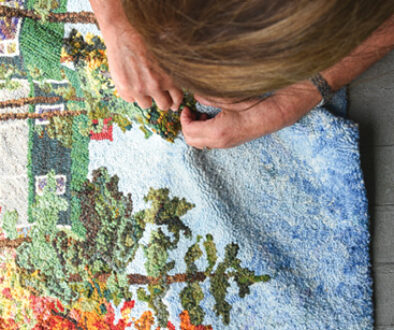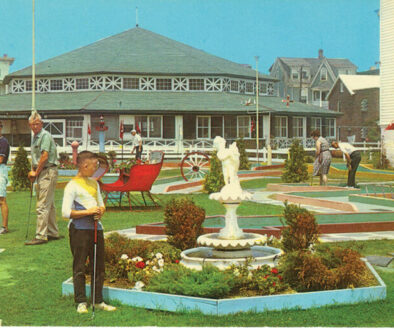Clean Getaway
The Bygone Era of Cape May’s Bath Houses

A day trip down the shore is a magical, almost-perfect thing. Hop in the car at sunrise, hightail it down 55 or the Garden State Parkway and be sitting on the sand by 9am. But hours later, when it’s time for the drive back home or to freshen up for an evening out, day trippers face a universal problem.
“The beach is great. I just don’t like having to walk around under layers of sand for the rest of the day,” Jason Harting, of Philadelphia, told reporter Lauren Suit in an interview for the July 31, 2007 Cape May County Herald as he was exiting Wildwood’s beach with a group of friends.
Although it’s certainly possible to make oneself presentable by rinsing off at one of the open showers at a few of the beach entrances or in one of the public restrooms along the promenade, the situation is less than ideal.
From the latter part of the 19th century to the mid-20th century, bath houses addressed beachgoers’ needs, offering lockers to store clothes, private showers, towels, and often other amenities. Situated near the beach, the structures were often an extension of a hotel or related business.
Betty Steger is a member of the family that still owns Steger Beach Service, which rents beach boxes, umbrellas, cabanas, chairs, and related beach gear. Her father-in-law originally bought the business in 1932, and at the time, Atlantic Bath House was the major part of the enterprise, supplemented by a minimal presence in beach amenities. When she married into the Steger family in 1951, she and her husband, Bob, ran the store and the bath house, while her father-in-law took care of the rental stands on all the beaches.

She remembers their bath house well—comprised of five rows of rooms, with lockers on either side. Sunbathers returning from the beach for the day would drop their sandy suits outside. “This was in the days before dryers,” she recollects, “so we would wash them and hang them on a clothesline on the roof of the building.” Once the garments were dry, they would be returned to the lockers for customers to use the next day.
The facilities were ubiquitous because they were a necessity for almost everyone, in part due to the social conventions of the time. “In the 30s and 40s, you were not allowed to walk in any of the hotels with a bathing suit on—you had to have a locker at a bath house to take it off,” Steger recounts. “Way back in the early 1900s, men and women weren’t allowed on the beach at the same time. Men went on the beach in the morning and women went in the afternoon. Women likely slept in and primped themselves for their afternoon on the beach, while the men probably played tennis or golf in the afternoon.”
Robert Fite and his family owned the Colonial Hotel (now the Inn of Cape May) from 1930 to 1985. When they purchased the property, the entire beach block in front of it was replete with bath houses that were originally built as part of the Stockton Hotel in 1869, and extended from Gurney and Howard streets all the way back to Columbia. “Back then, suits covered up the whole female—a lot different than these bikinis today,” Fite said with a laugh.
“Back in the late 1880s, people wore big wool bathing suits, and you had to be dressed at all times,” adds Steven Steger, Vice President of Steger Beach Service. “So you needed to go someplace to get adjusted. Some people erected tents on the beach, but the bath houses were there. Pretty much every sizeable hotel had one.”
Bath houses served day trippers as well. “We called them shoobies,” Fite recalls. “Because they would come down from Philly by train, and they would bring their lunches in shoeboxes.” In those days, trippers could rent a bath house unit for the day, and even a bathing suit. “For fifty cents a day, they had a place to change, and we’d even wash and dry their suits,” says Fite.

Back in the heyday, bath house goings-on would even make the news, such as that time in 1906 when a Cape May beachgoer dropped dead. “Saved from drowning, Joseph F. Clark died of heart disease today under a shower sprinkler at a bath house here,” announced The New York Times on August 24, 1906. After lifeguards rescued an exhausted Clark from the unusually ferocious waves, “he recovered sufficiently to walk to the bath house, but dropped dead immediately after turning on the shower.” Just two days prior, Clark, employed by the Chesapeake Steamship Company, had performed an ocean rescue of his own, saving two drowning women.
So where did all the bath houses go?
The times—and most importantly, the mode of commuting down to the shore—have changed. “In the days when trains brought thousands of visitors from Philadelphia and the western part of South Jersey, it was common for the tourists to rely on the bath houses,” wrote Tim Kelly in the August 18, 2016 edition of the OCNJDaily. “Where public showers abounded in town and throughout the Jersey Shore since the early 1900s, their numbers decreased through the years and have now all but disappeared.”
Today, only one bath house even still exists at the Jersey Shore—the 13th St. Bath House owned by Tony and Janet Galante in Ocean City, New Jersey. “I think we are the last one in the tri-county area,” Tony Galante told Kelly in the article.

The Shields Bath Houses were located between the King Cottage (left, at Beach and Jackson where a mini golf course is today) and Arnold’s Hotel (today Cabanas). Pictured is Kay Smouse on the beach in Cape May. July 3, 1925. Photo from Archive.org
At Steger’s, the bath house remained open until the 1950s, when it was slowly converted to Steger Surf and Sun, a beach store and surf shop, one of the first of its kind in South Jersey. “The bath house era was beginning to dwindle,” relates Betty Steger, so her husband tore out the structures and began making the store larger. “We would open at 7:30 in the morning, and people who were staying at the hotel would give their children five dollars and say, ‘Go down to Steger’s and get lost.’ We’d laugh when all these kids would arrive early in the morning, because we knew that Mom and Dad were having some private time back in the room.”
The huge collection of bath houses at Bob Fite’s Colonial Hotel was whittled down over the years as well. “When we had the Colonial, we took down 300 to give the hotel beachfront views,” he says. As the Colonial focused on increasing its beachfront presence, more of its bath houses came down, replaced by a big lawn and a swimming pool in the 1960s.
What else stands in their place? Parking lots. When cars replaced trains, horse-drawn carriages, and steamships as the primary mode of travel, the big hotels responded with pavement. “Parking lots became so much more profitable,” explains Steven Steger. “And needed. The historic district streets are so narrow because they were designed for horse and buggy traffic, and not for parking cars.”
And yet, not all resort areas are throwing in the towel, as evidenced by the $65 million project at Jones Beach State Park in New York that includes renovation for its historic—but crumbling—East and West Bathhouses. In an April 4, 2014 article in The New York Times, Rose Harvey, commissioner of the state’s Office of Parks, Recreation and Historic Preservation, stated, “The East and West Bathhouses are central to the historic grandeur of Jones Beach. We need to recognize and celebrate that legacy, but we also need to make them relevant to the 21st-century visitor.”
“It was very formal in the 1930s. You would never come to the beach in your beach clothes. You’d rent a suit and a towel and check your clothes,” added John Krawchuk, director of historic preservation for the city’s parks department. “These bathhouses were erected at a time when people dressed up for a day at the beach. Instead of grabbing a tuna sandwich from the cooler, beachgoers supped in the bathhouses’ dining rooms, with their white tablecloths and glassware, and donned their suits in changing rooms.”
New York made good on its investment, too, with the West Bathhouse celebrating its grand re-opening on July 27, 2017. Even Governor Andrew Cuomo stopped by for a tour and a visit to its resident restaurant, the newly renovated The Landing at Jones Beach. “It was destroyed, basically,’ the polo-shirted Cuomo told the audience,” as reported in the August 3, 2017 edition of Long Island Press. “To see it come back to grandeur fills my heart with a sense of pride.”

On this map from 1909, you can see the former locations of Shields Bath Houses and the Stockton Surf Baths. That same year, Maguire’s Bath House operated at Jackson and Beach, and R.M. Benstead Bath Houses and P.F. Quidort Bath Houses were located across from each other at Perry and Beach. Sanborn-Perris Map Co., Limited, 1909. (A map from 1890 shows that Shields was previously called the Excelsior Baths, and that E.C. Knight had operated the bath house between Perry and Jackson. According to the book Cape May in Vintage Postcards by Don and Pat Pocher, by 1878, there were over 2,000 bath houses on the beachfront. The Stockton Baths had 1,000 rooms.)
Might Cape May’s landscape follow a similar resurgence? Although there are no plans for now, it wouldn’t surprise Steven Steger to see a bath house pop up. “If the city-owned properties decided ‘Hey, let’s put a public bath house here and charge for it,’ then people could go to dinner or go to work from the beach.” The big question is location. Steger can imagine building it on pilings right on the dunes. “You could do it tastefully, on certain beaches, in line with the promenade. Sure, there would be public outcry, but as long as it wasn’t done in a sensitive area, it could benefit the city and the people,” he maintains. “The city could sell beach tags, just like [they do at] the snack stand at Broadway or the arcade.”
One thing is certain: Even as Cape May’s bath houses disappeared one by one, remnants of those who visited them endure. Case in point: Philadelphia resident Frank Digman’s moniker scratched onto the flagpole at King’s bath house, which once stood on the beachfront. On the morning of June 28, 1924, workers employed by local contractor Sherman S. Sharpe were tearing down the tower and flagpole at King’s when they discovered Digman’s name written in lead pencil, along with “June 28, 1879.” “Despite the many storms that have raged along the Atlantic Coast for forty-five years,” reported The New York Times of the same date, “workmen say that the name and date were perfectly legible.”
Perhaps Digman carving his name into the flagpole at King’s bath house during his beach vacation so long ago reminds us of the permanence of our own beach memories, and that even the sturdiness of the brick and mortar bath houses turned out to be no more durable than those memories.


Smith’s Studio
Sidebar text by Jessica Leeburg. Photographs by Michelle Giorla
While we were assembling art for this article, we made a point to photograph this building on Lafayette Street (today Elaine’s Boutique), which we’d been told was once one of the Stockton bath houses. We’ve published that information on CapeMay.com and in Cape May Magazine. But while our photographer was on site, she noted that the building looked larger than the bath houses in the early 1900s photographs. And unless it had undergone significant structural changes, the rooflines didn’t match up either.
Shirley Phinney of Elaine’s Boutique told us that the building had not been a bath house at all. Research found it was actually Smith’s Studio (visible in the black and white photo acove, on the far left). Smith’s was a photography studio at Ocean and Beach Avenue, next to the Stockton Bath Houses. It would later be known as Ping Pong. Photo comparison shows identical rooflines and detail on an exterior door.
We also went to the Beach Club in hopes of photographing the bath house that had supposedly been moved there as an office, but we were told it has been demolished.



